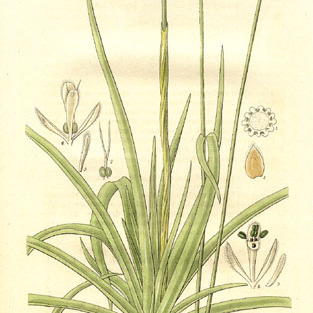Herbs, perennial, 30--110 cm. Leaves linear or linear-attenuate, abruptly, then gradually, narrowing, 10--40(--50) cm, apex acute or obtuse. Inflorescences: scape sheaths shorter than principal leaves; scapes linear, distally 1--2(--3) mm wide, multiribbed; heads dull white, hemispheric to nearly globose, 7--15 mm wide, hard, very slightly flattened when pressed; receptacle copiously hairy; involucral bracts reflexed, obscured by reflexed proximal bracteoles and flowers, straw-colored, narrowly ovate to lanceolate, 2--4 mm, margins erose to entire, apex acute, glabrous or apex with white, club-shaped hairs; inner bracts and receptacular bracteoles pale, linear to oblong or lanceolate, 3--4 mm, margins entire, sometimes becoming erose, apex narrowly acuminate, glabrous or apex with white, club-shaped hairs. Staminate flowers: sepals 2, yellow-white, linear, curved, 3 mm, distal surface abaxially, adaxially with white, club-shaped hairs; androphore club-shaped; petals 2, yellow-white, translucent, triangular to linear, nearly equal, with small tuft of white, club-shaped hairs abaxially at apex; stamens 4; anthers black. Pistillate flowers: sepals 2, yellow-white, linear, 2--3 mm, apex acute, abaxially with white, club-shaped hairs at apex; petals 2, pale, spatulate or narrowly elliptic, 1--2 mm, abaxially with translucent hairs proximally, white, club-shaped hairs distally, or adaxially glabrescent; pistil 2-carpellate. Seeds pale brown, ellipsoid, 0.75--1 mm, very finely cancellate or sometimes with cancellae concealed by rows of delicate nearly appressed hairs.
More
Densely tufted; lvs firm, mostly 10–40 cm, tapering evenly from the broad (1–4 cm), spongy, translucent base to the narrow but blunt tip, many-nerved, the cross-veinlets inconspicuous or wanting; scapes 1–3 per rosette, rigid, 3–10 dm, twisted, 8–12-ridged, 1–3 mm wide just below the head, scape-sheath surpassed by the lvs; heads bisexual, at maturity subglobose, 7–15+ mm thick, hard, dull white, the outermost fls reflexed and obscuring the invol bracts, these stramineous, lanceolate to narrowly ovate, 3–4 mm, acute, white-hairy distally; receptacle copiously long-villous, its bracts narrowly acute to acuminate, with pale, shortly protruding, often hairy tip; perianth pubescent distally with cylindric-clavate hairs 0.2–0.5 mm. Moist but seldom permanently wet places; N.J. to Fla. and Tex., mainly on the coastal plain, but also in the mts. of N.C. July–Sept.

